Fall Sale!
Get 20% OFF using Coupon Code: KLFALL25
Trainz Steam Locomotives
by Steve Lerro
Fall Sale!
Get 20% OFF using Coupon Code: KLFALL25
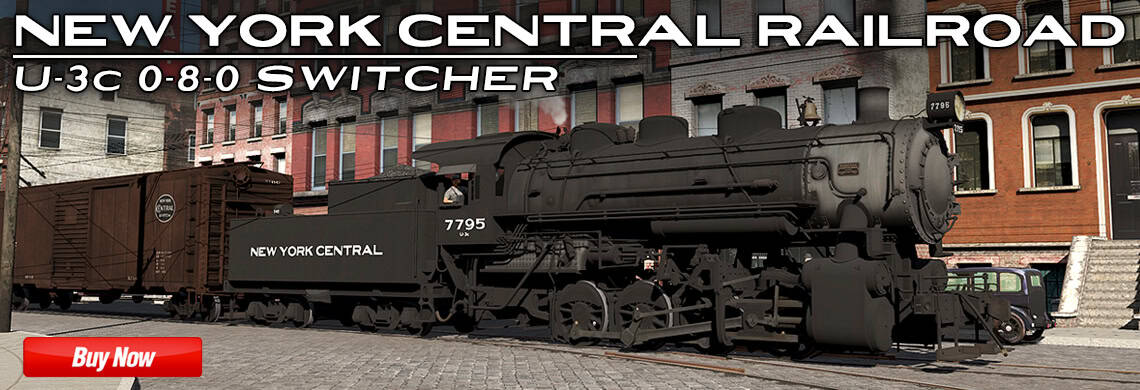
by Steve Lerro
K&L Trainz is proud to welcome the New York Central U-3c 0-8-0 Switcher to the roundhouse!
The NYC U-3c Switcher set includes: (3) Engines & (3) Tenders
Buy now
by
The New York Central’s U-3c class was just one of many 0-8-0 designs utilized by the railroad. A total of (70) were built in 1922 by both the Lima Locomotive Works in Lima Ohio and the American Locomotive Company in Schenectady, NY, and all were based off earlier USRA designs. The (35) built by Lima operated at 175 psi and produced 50,060 lbs of tractive effort, while the (35) built by Alco operated at 180 psi and produced 51,490 lbs of tractive effort. All had 52″ drivers, as well as baker valve gear and power reversers. They utilized slightly shorter tenders than what the previous classes had, with a capacity of 11 tons of coal and 8200 gallons of water. Fully loaded, the engine and tender combined weighed in at 379,100 lbs.
The U-3c’s could be found systemwide from New York to Illinois, as well as on most of the NYC’s subsidiary lines handling switching of rolling stock and maneuvering locomotives in the shop areas. A few even found themselves on local freights on branchlines.
All were withdrawn from service by 1956, with the last being officially retired in 1959.
None of the (70) U-3c’s were preserved, nor were any of the nearly (700) other 0-8-0’s the railroad owned.
The NYC U-3c Switcher set includes: (3) Engines & (3) Tenders

by
#850 was a one-off compound mallet built by the Lima Locomotive Works in 1918. Influenced by Alco’s 2-6-6-0 Class 76’s built in 1913 for the Denver & Salt Lake Railroad in Colorado, #850 was specifically designed to be a smaller branch line variation utilized in the east coast coal mining regions. The idea was that a smaller wheelbase and lighter axle load would permit the engine to navigate even tighter turns and operate on lighter rail. #850 operated at 225psi, sat on 50″ drivers, and produced 70,000 lbs of tractive effort. Her tender held 18 tons of coal and 8500 gallons of water. She was happiest and most efficient running 15-20mph, but was capable of reaching speeds exceeding 30mph on more level trackage.
However it was found that the existing large 2-8-0’s of the time were already capable of pulling 70-80% of what #850 was, and being a compound mallet made #850 a more labor intense locomotive to maintain. Twice the engine without anywhere near twice the power output. By March of 1919, #850 found herself without an owner and destined to be scrapped, having been deemed unsuccessful.
At the same time, a new railroad was being formed in Richmond, VA, which intended to reach the coal regions of Peabody and Parker. Seeing a need for new power, the newly formed RP&P took interest and tested #850, finding that the mallet performed well on their line; having no issues with their curves, grades and general infrastructure. The RP&P purchased #850, and she was immediately placed into fulltime service.
By 1950, the costs of operating the complicated mallet had caught up to the RP&P, and #850 was sidelined by newer diesels. She was officially retired in 1951, and was placed on display at the railroad’s Richmond Station. In 1985, a major effort was undertaken to relocate the Richmond Station due to constant flooding. This resulted in #850 being relocated as well. The move proved more difficult than anticipated, see #850 derailed twice, and a 3rd was narrowly avoided. It was decided to remove the pilot wheel, and the engine was towed to the Richmond Engine Shops to receive a cosmetic restoration.
While being overhauled, new management assumed control of the RP&P. Being a fan of steam, the new CEO approved the costs for a feasibility study to determine if #850 was financially worthy of being restored to operation. The results showed that the engine was in-fact capable of being restored, but the costs were significantly higher than expected. A number of fundraisers were held, and after 2 years, restoration work finally began to bring #850 back to life. In 1993 after 6 solid years of work, #850 ran on her RP&P home rails for the first time in 43 years. She has remained in operation ever since and is used periodically each month for revenue freight and special events.
Tonnage rating on Coal Country 2.0:
1100 tons from Parker to Richmond via Peabody on the original mainline with 2.5% grade.
1500 tons from Parker to Richmond via Clackline, Lefroy and Burning Fork on the newly added line.
#850 was built using:
Boiler, smokebox, firebox and domes from the Frisco USRA1 Mikado – The boiler, smokebox and firebox were rebuilt.
Cab interior and exterior from P&B Pacific #1086 – The cab roof was re-arched, windows squared off, and interior painted green.
Drivers, frame and rear cylinders from A&A Consolidation #18 – The wheels were rebuilt and running gear reanimated.
Bell from H&W F1a Consolidation – The bell, bell saddle, and cord were all rebuilt and reanimated.
Pilot wheel from N&W M Class Mastodon.
Tender from R&N Pacific #425 – Slope sheet and headlight were replaced. Added a footboard pilot.
Various parts such as the compressors, headlight, whistle, safety valves, lubricators and reverser were all taken from various K&L engines, most of which ended up being rebuilt using the originals at templates. All new piping, reverse linkage, cab curtains, footboard pilot, low pressure cylinders and many other smaller details were built. New textures have been applied as well.
After 13 years, class lights have finally been added. They’re primitive at the moment, but will evolve with future releases. And lastly the old reflective wheel tire faces have finally been retired.
K&L’s first true Frankenstein Kitbash. Hope you enjoy it!
RP&P N-2 Class Mallet #850 set includes (1) Engine, (1) Tender
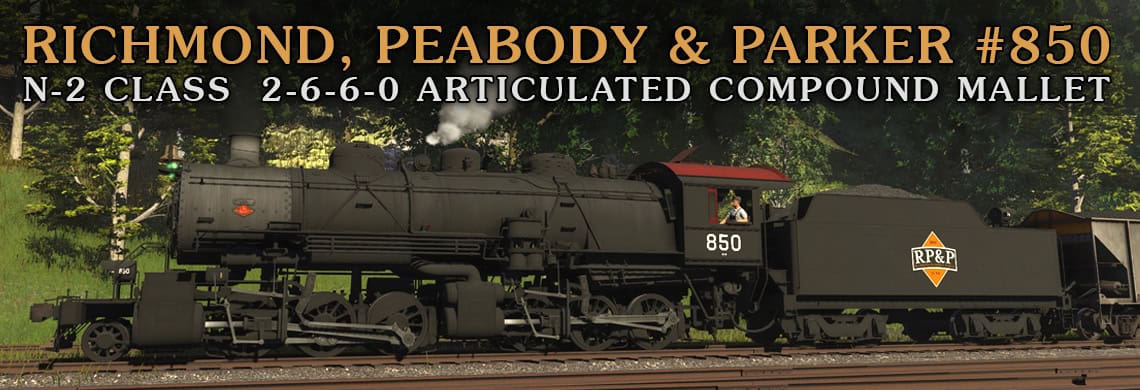
by Steve Lerro
K&L Trainz has joined forces once again with Jointed Rail to bring you another locomotive/route collaboration.
Coal Country 2.0 has been released, and what better way to explore the new route than with a new locomotive!
We’re proud to present the RP&P’s N-2 Class 2-6-6-0 Articulated Compound Mallet #850.
Comprised of elements from over a dozen former K&L locomotives, this engine has been designed to tackle the 2.5% grades, as well as negotiate the extremely tight turns found on the new Coal Country 2.0 route.
Get your copy of the route at: https://jointedrail.com/product/coal-country-trs19-trs22/
Buy now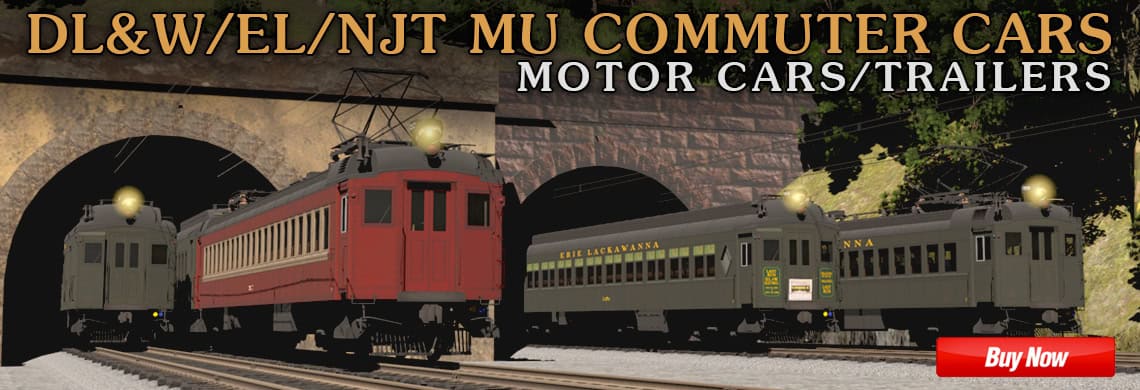
by Steve Lerro
K&L Trainz is proud to welcome to the DL&W/EL/NJT MU Commuter Cars to the roster!
The DL&W/EL/NJT MU Megapack Includes:
(3) Low Roof Motor Cars, (3) Low Roof Coach Trailer Cars, (3) High Roof Coach Trailer Cars, (3) High Roof Combine Trailer Cars, (2) High Roof Club Trailer Cars, (5) As-built Non-MU cars
Buy now
by
Between 1929 and 1930, the Delaware, Lackawanna & Western (DL&W) set about electrifying it’s Morristown Line and related branches out of Hoboken, NJ. A total of (141) powered motor cars were built by GE and Pullman to operate on these electrified lines. They were propelled by (4) 225hp DC traction motors, allowing a maximum speed of 63mph on level track, and 75mph on downgrades. Power was provided by 3000 volt AC overhead wires, captured by a pair of roof-mounted pantographs. They were supplemented by (141) unpowered trailer cars of various types, which were converted from existing passenger cars. These multi-unit (MU) cars operated in semi-permanently coupled pairs consisting of a powered unit and one of the non-powered trailers. Off-peak trains were typically 4 cars, while peak trains were anywhere from 8-12 cars. A single accident in 1962 saw the loss of a trailer car, resulting in it’s motor car being placed in a 13 car lash up, nicknamed the “Tom Taber Express”.
The MU cars were inaugurated on September 3, 1930, with Thomas A. Edison at the controls for the first of 13 miles to Montclair, NJ. The MU cars lasted 54 years, seeing service under the DL&W from 1930-1960, the Erie Lackawanna from 1960-1976, then Conrail from 1976-1982, and finally New Jersey Transit from 1983-1984. They retained their Pullman green and gold lettering paint scheme until the very end when NJT began painting a number of the cars red and cream. The final runs came with much fanfare on August 24, 1984. The DC power system was also subsequently retired.
Of the (282) MU cars, a total of (59) Motor cars, and (97) Trailer cars were preserved. Most were sold to tourist railroads, including:
Everett Railroad
Grapevine Vintage Railroad
Middletown and Hummelstown Railroad
Reading Blue Mountain and Northern Railroad
Steamtown National Historic Site
Strasburg Railroad
Valley Railroad Company
Whippany Railway Museum
The DL&W/EL/NJT MU Megapack Includes: (3) Low Roof Motor Cars, (3) Low Roof Coach Trailer Cars, (3) High Roof Coach Trailer Cars, (3) High Roof Combine Trailer Cars, (3) High Roof Club Trailer Cars, (5) As-built Non-MU cars

by Steve Lerro
K&L Trainz is proud to welcome to the CP F1a 4-4-4 Jubilee to the roster!
The CP F1a Jubilee set includes: (2) Engines, (1) Tender, (1) Express Reefer, (1) Lightweight Baggage Car, (1) Heavyweight Combine, (1) Heavyweight Coach, (1) Lightweight Coach, and (1) Lightweight Observation Car.
Buy now
by
The Canadian Pacific Railway constructed (20) 4-4-4 Jubilee type locomotives in 1937-1938. These F1a class engines, numbered 2910-2929, succeeded (5) slightly larger F2a locomotives built in 1936. While the unusual 4-4-4 wheel arrangement never caught on with other North American railroads, the Canadian Pacific’s design proved successful. The appearance of the F1a locomotives stems from the F2a design. An emphasis was placed on “Semi-Streamlining”, and no extremes were considered with the shrouding. This was done to keep crucial areas of the engine readily available for servicing and repairs. Thus why the shrouding was kept almost completely in-tact throughout their entire careers. The appearance was so successful that it was adapted to the later H1c and H1d Royal Hudsons of 1938 and 1940, and the T1b and T1c Selkirks of 1938 and 1949.
The F1a Jubilees employed a fairly small boiler, measuring 6ft diameter. With the outer streamlined casing, that increased to nearly 8ft. They sat on 75″ driver wheels, with the main road connected to the rear axle. Smaller 16.5 x 18″ cylinders, and an exceptionally high 300psi boiler pressure gave these engines a total 25,900 lbs. of tractive effort. It was also unusual to see such a small engine equipped with a Front End Throttle and an Elesco Feedwater Heater. Unlike the prior F2a locomotives, these newer F1a’s lacked a mechanical stoker and a power reverse gear. They were all hand fired, and incorporated the traditional screw reverse wheel. An all-weather cab provided warmth in the harsh winter climates. Their tenders had a capacity of 12 tons of coal, and 7700 imperial gallons (9247 US gallons) of water. Total engine and tender weight was 192,777 lbs.
The F1a’s were designed with the intention of running short and fast intercity local commuter and express trains. This service never really materialized, and they found themselves used on secondary local passenger trains, and on the prairies in Eastern Canada. They were also used on short mixed trains. One notable assignment was the 41 mile Regina-Moose Jaw, Saskatchewan local. This train was required to make 10.2 miles in 10 minutes between Pasqua and Belle Plaine, averaging a start to stop speed of 61mph within 10.2 miles! This for a time in the late 1940s and early 50s was the fastest scheduled speed attained by a Canadian passenger train.
The F1a’s were finally retired in the late 1950’s, and all but (2) were scrapped.
#2928 was acquired by the Canadian Railway Museum in the mid-1960s for display. Today the 2928 is undergoing a cosmetic restoration at the Museum.
Canadian Railway Museum Site
#2929 was purchased by F Nelson Blount for exhibition with his collection of historic steam locomotives in Wakefield, Massachusetts. The 2929 and the rest of the collection were moved to North Walpole, New Hampshire in 1960 to become part of the Steamtown Foundation. After his death in 1967, the 2929 and others fell victim to deterioration due to lack of funding. The collection was eventually moved to Scranton, PA in 1984, where the National Park Service took over in 1995. Today the 2929 sits outside away from the public viewing area awaiting an asbestos abatement. There are no plans to restore the 2929 to operation.
Steamtown National Historic Site
The CP F1a Jubilee set includes: (2) Engines, (1) Tender, (1) Express Reefer, (1) Lightweight Baggage Car, (1) Heavyweight Combine, (1) Heavyweight Coach, (1) Lightweight Coach, and (1) Lightweight Observation Car.
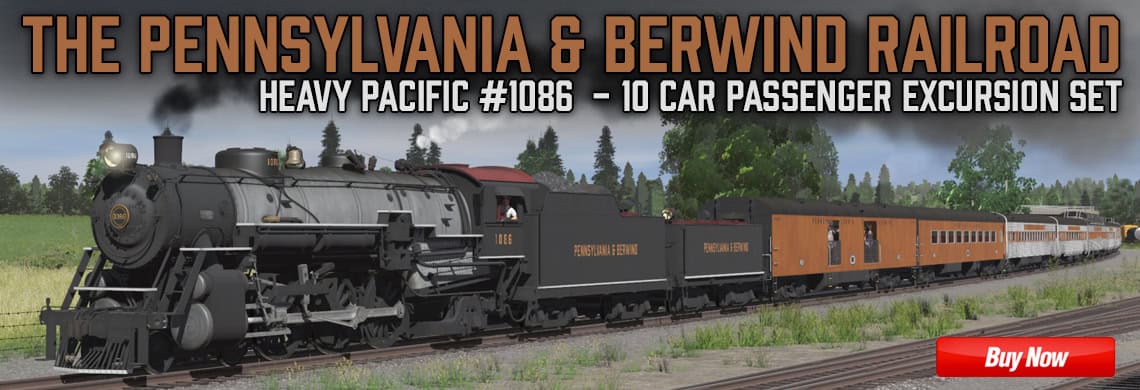
by Steve Lerro
K&L Trainz has collaborated once again with Approach Medium to bring you the Pennsylvania & Berwind #1086 Excursion set! As well as the newly updated and modernized P&B Route V2.0!
The P&B 1086 set includes: (3) Engines, (2) Tenders, (1) Aux Tender (10) Passenger cars.
Buy now
by
The St. Louis & Lexington Railroad took delivery of the 1086 in July of 1929. She was the largest and heaviest locomotive built for the railroad at that time, with her design closely resembling the Southern Ps-4 Pacifics. She was used in heavy passenger train service, pulling the railroad’s finest and fastest trains. In 1951 after 22 years and nearly a million and a half miles of service, the 1086 was displaced by newer modern diesels. She was stored serviceable for 3 more years, never being fired up again. She was officially retired in 1954, and sold for scrap to local Lexington KY scrapper: Baker Iron & Metal. In 1956, a petition was started by Lexington railfans to save the 1086 from being scrapped. With 25000 signatures acquired in just 30 days, the locomotive was indeed saved from scrapping, and Baker Iron & Metal donated the engine to the city of Lexington.
The 1086 was placed on display at the newly developed Arcadia Park in Southern Lexington. After 58 years, the park was repurposed for newer housing developments, so the 1086 found herself in need of a new home. She was moved 85 miles west to Elizabethtown, KY, where she sat for 4 years until the Pennsylvania & Berwind Railroad purchased her in October 2018.
She arrived at the P&B on May 14th, 2019, and underwent an extensive 5 year restoration. She was successfully fired up for the first time on September 20, 2023, and made her first movements under her own power on March 23, 2024. Her grand debute came on June 14th, 2024 at the start of Allegheny’s 3rd annual Railroad Days Celebration.
The P&B 1086 set includes: (3) Engines, (2) Tenders, (1) Aux Tender (10) Passenger cars.
SL&L Pacific Engine & Tender
P&B Pacific Engine V1 Silver
P&B Pacific Engine V2 Black
P&B Pacific Tender
Power Generator Car – #100
Concession Giftshop Car – #200
Archroof Coach – #400, 401, 402, 403, 404, 405, 406
Coach PS Silver – #800, 802, 804, 806, 808
Lounge PS Orange – #700, 702, 705
Lounge Budd Silver – #950, 952, 953
Super Dome Silver – #300, 305
Observation Budd Silver – #900
Open Air Gondola – #301, 308
Open Air Coach – #500, 501, 502
by Steve Lerro
I was finally able to fix the issue plaguing the Boiler Blowdown and Water Scoop effect, causing it to stay on with no sound. To fix the issue, simply download the cdp file linked below and install it. All blowdown and water scoops should work as normal again! Keep in mind, it may take a second or two for the blowdown/water scoop to stop once you let go of the key to operate it.
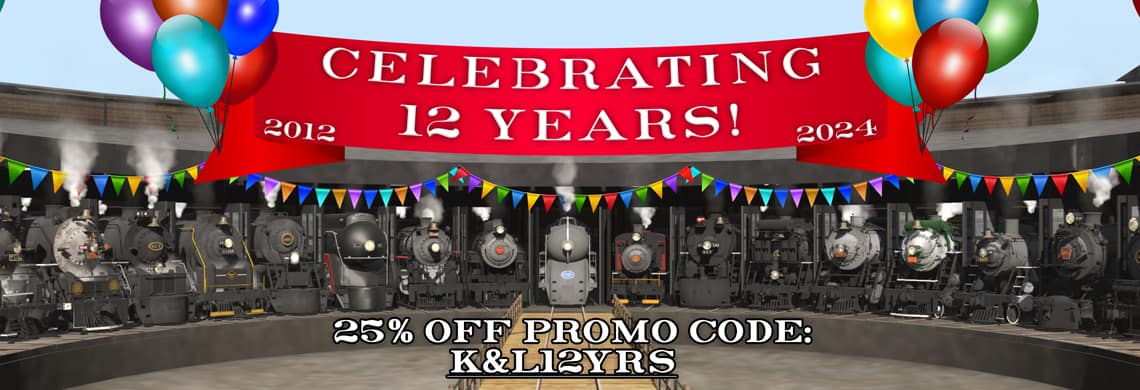
by Steve Lerro
K&L Trainz Celebrates 12 Years! Use Coupon/Promo code K&L12YRS at checkout to receive 25% off current sale prices.
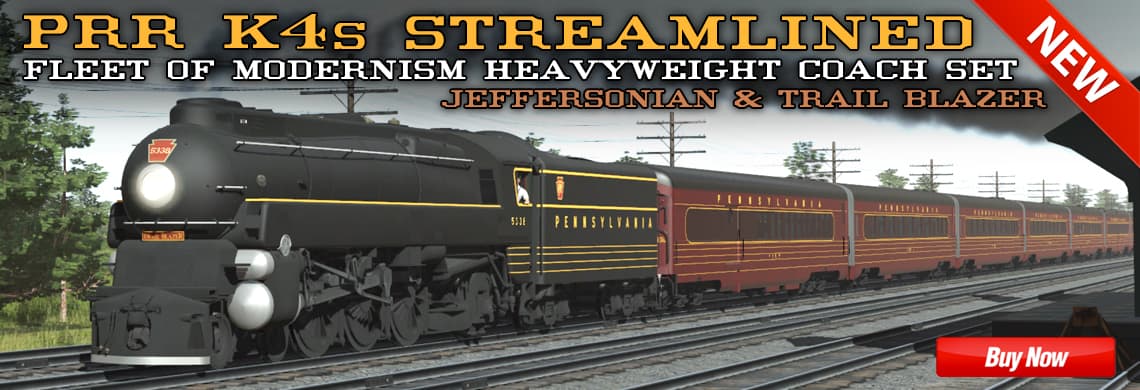
by Steve Lerro
Ride from New York to Chicago and St. Louis in style on the all new Jeffersonian and Trail Blazer and trainsets! The PRR K4s Streamlined Pacific with Deluxe All-Coach Fleet of Modernism is here!
The PRR K4s Streamlined set includes: (1) Engine, (1) Tender, (1) Combine, (2) Coaches, (1) Diner, (1) Kitchen/Dorm, (1) Observation
Buy now
by
The TRAIL BLAZER
On July 28th, 1939, the Pennsylvania Railroad officially began it’s Trail Blazer service between New York and Chicago via Philadelphia and Pittsburgh. Using existing P70 coaches and other heavyweight cars, the train was streamlined and painted to match the railroads famed Fleet of Modernism consists of the Broadway Limited. Skirting was added along the bottoms of the cars, the roofs were cut down to match the contour of the lightweight Pullmans, and they were painted in the tuscan red with maroon over the windows, along with black handrails and a generous amount of gold pinstriping. The gaps between the cars was completely covered in light gray.
The train was such a success that reservations needed to be made 6 weeks in advance. Originally expected to only be (8) cars long, it quickly became (10), and eventually as much as (14) cars by 1943. It was so popular and profitable, that it carried 35 times more passengers than the Broadway Limited, and in 1940 it grosed over $2.2 million, or $47,900,000 in 2023 dollars! It was also one of the railroad’s heaviest trains, averaging over 1000 tons, and often required double heading. The Trail Blazer ran as #76 eastbound and #77 westbound from July 28, 1939, until July 26, 1959, just 2 days shy of 20 years.
The train comprised of:
PB70ER Baggage-Lounge car – Formerly a PB70 Combine
Multiple P70KR and P70GSR Reclining Coaches – Formerly P70 Coaches
D70CR Full Dining Car – Formerly a D70 Diner
D70DR Kitchen-Crew Dormitory – Former a D70 Diner
POC70R Observation-Diner-Lounge – Formerly a P70 Coach
The JEFFERSONIAN
In 1941, with the success of the Trail Blazer, the PRR began operating The Jeffersonian; a similar deluxe all-coach service from New York to St. Louis, utilizing similar equipment. The train ran as #65 westbound and #64 eastbound from 1941 to 1956.
Locomotives #1120, #2665, #3678 & #5338
In December 1940, K4s engines #1120 and #2665 were selected to be semi-streamlined for the railroads new South Wind train that ran from Chicago to Miami. Unlike the earlier Torpedo engine #3768, these engines had a much simpler streamlined design, consisting of a bullet nose, skyline casting, angle cab walls, pin-striping, and short 110P75 tender. The pin striping under the cab and on the tender lined up with the Fleet of Modernism paint scheme, which provided an aesthetically pleasing continuation from engine to observation car.
Early the next year, K4s engines #3678 and #5338 were given the same streamlining and were assigned to the Jeffersonian. Eventually they saw use on the Trail Blazer, the Broadway Limited (New York to Chicago), the Liberty Limited (Washington to Chicago), and the Cincinnati Limited (New York to Cincinnati). The streamline shrouding was removed by the early 1950s.
None of the (4) Streamlined K4s were preserved.
The PRR K4s Streamlined set includes: (1) Engine, (1) Tender, (1) Combine, (2) Coaches, (1) Diner, (1) Kitchen/Dorm, (1) Observation
